Verizon iPhone 4: Thoroughly Reviewed
by Brian Klug on February 13, 2011 9:32 AM ESTCDMA vs GSM/UMTS iPhone 4 Nuances
There are a bunch of other subtle differences between the two iPhone 4 models, but they're relatively small things.
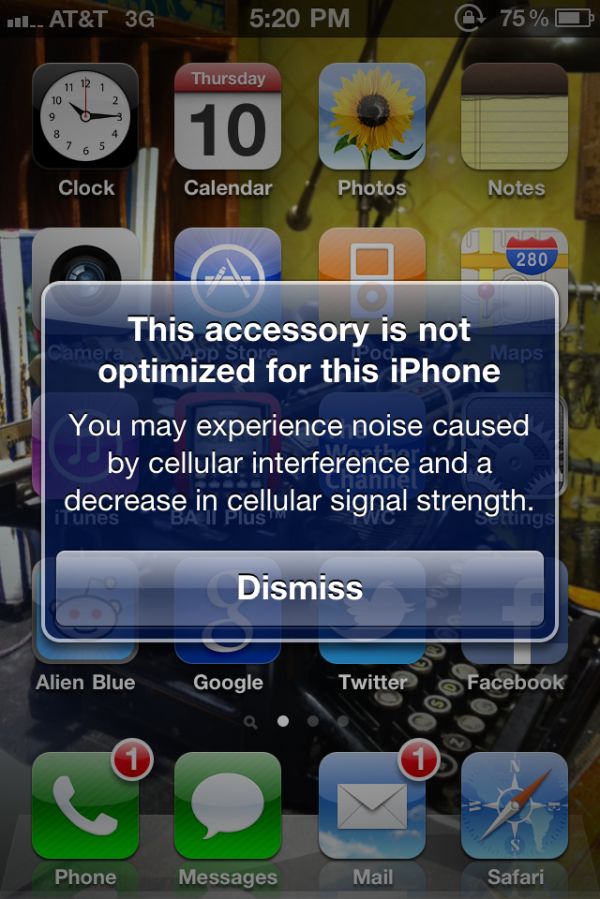
Accessory connection warning change - Left: AT&T iPhone 4, Right: Verizon iPhone 4
First off, the "audio interference" warning that's stuck around since the first iPhone is gone, like it should be.
Remember that 2G GSM/EDGE is TDMA - Time Division Multiple Access. In that multiplexing scheme, each phone gets assigned timeslots to transmit and receive during. When the phone is transmitting, because of the very short nature of those timeslots, instantaneous power looks like a delta function - it's a huge instantaneous pulse, even though time-average power is comparatively low. Well, the spacing of those pulses inside a multiframe is 4.62 ms, which corresponds to a very audible 217 Hz. This induces audible interference in unshielded audio systems. The solution Apple came up with was to require new approved accessory devices to shield components appropriately, and use an IC that would tell the device it was shielded. Other older devices pop up an alert about audio interference. Although 3G UMTS uses WCDMA, (which is fundamentally the same multiplexing scheme as CDMA2000, just a wider channel) the alert pops up regardless of whether the AT&T iPhone is on 2G or 3G. The phone can transmit continuously (no short, bursty nature) across the entire channel, and interference doesn't occur.
If you connect up a GSM iPhone to something that isn't shielded, you used to get that above dialog regardless of whether you're on 2G or 3G. Apple removed the audio interference part of that message, instead only warning about some attenuation which might happen from using a dock or battery.
There aren't too many other notable things - it's the same app store and interface as the AT&T version. There's no Verizon branded anything outside the carrier string. Of course, the fact that it's the same market means you can grab some AT&T specific apps like mark the spot and file some disingenuous bad signal reports. Maybe a tiny bit of app-segregation (or an API for determining whether the iPhone is CDMA or GSM/UMTS) could in fact be useful.
I noticed that the Verizon iPhone 4 also seems to get warmer than I remember the AT&T iPhone getting. It's something that's pronounced while charging or using 3G data a lot - perhaps the MDM6600 simply gets warmer than Infineon's X-Gold 618.
Screen slightly warmer
Our Verizon iPhone 4 review unit also has a noticeably warmer screen than the other AT&T iPhone 4s I've seen. Side by side with one, the difference is clearly visible. Our photos don't really do it justice, but the GSM/UMTS iPhone 4 is much more bluish than the Verizon iPhone 4, which has a warmer red hue.
I whipped out the X-Rite i1D2 used for display calibration and measured the white point. Sure enough, the Verizon iPhone 4 has a much different white point temperature than the AT&T iPhone 4. Brightness and black are similar enough to not be a huge difference, but that white point is seriously noticeable. Whereas the old iPhone 4 was reasonably close to 6500K, the panel in our Verizon iPhone 4 review unit is at 7120K. It doesn't show up in these photos or the overview video, but the difference is there.
Brightness and contrast are changed, but only slightly.
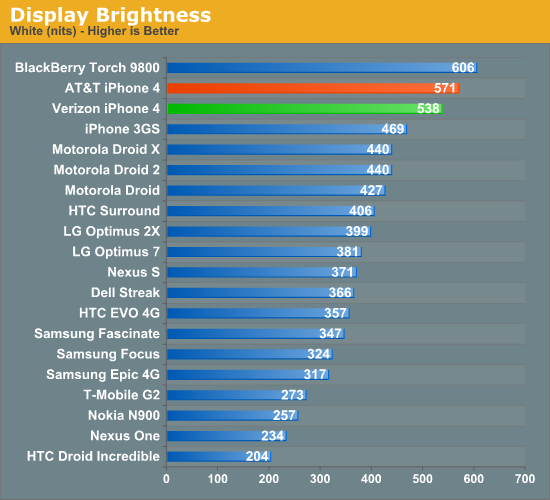
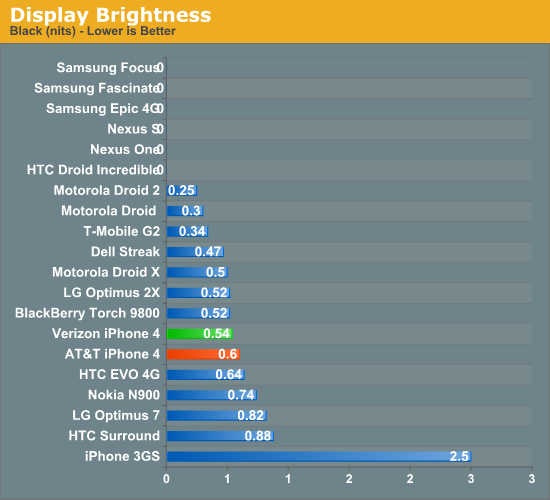
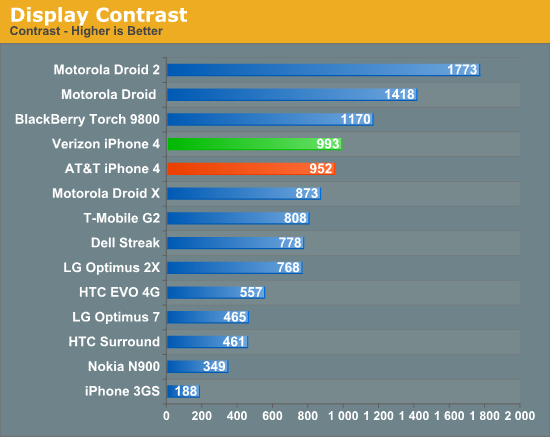
It's not clear whether Apple changed parts suppliers or this is simply a different batch of dissimilar panels. Either way, it's enough of a difference to be apparent almost immediately. The state of color accuracy on smartphones is awful to begin with, this is just another example of how huge the variance is even across a mature product line.
The Universal Bumper
To accommodate the moved insulate black strip, Apple also had to move the vibrate switch. It's slightly lower on the Verizon model, since leaving it in the exact same place as the AT&T version would've no doubt been too close to the end of the strip to be machinable.
The result is that new bumpers and cases are required. Apple sent a universal bumper, which has a longer vibrate port cut in the side to accommodate both versions of the iPhone 4. On both, you get a gap between the end of the vibrate switch and the port, but the result is that there's one bumper SKU.
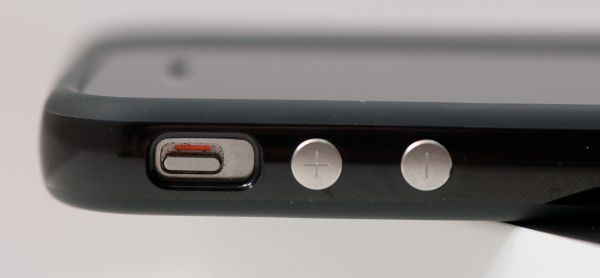
Top - Verizon iPhone 4, Bottom - AT&T iPhone 4 (in universal bumper)
Other legacy iPhone 4 cases are perfectly fine. For example, I use an Otterbox commuter which always had an oversized vibrate port. Luckily, it's just large enough to accommodate the Verizon iPhone. The position and feel of the volume up/down buttons is unchanged.




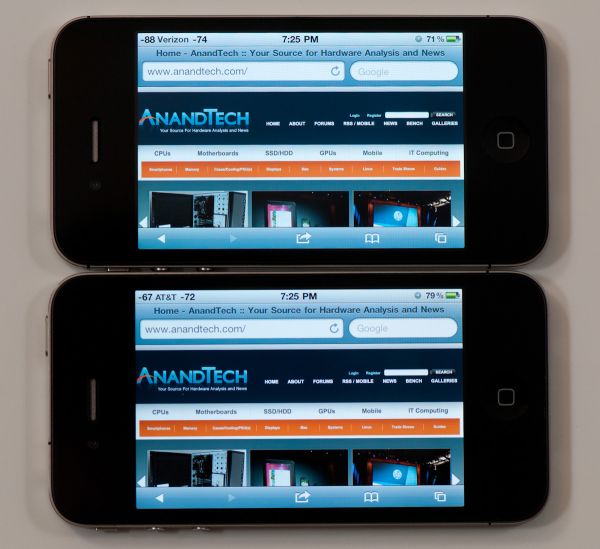
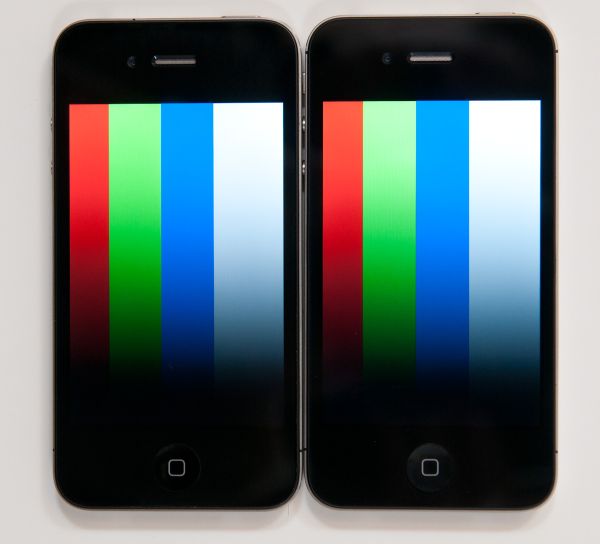
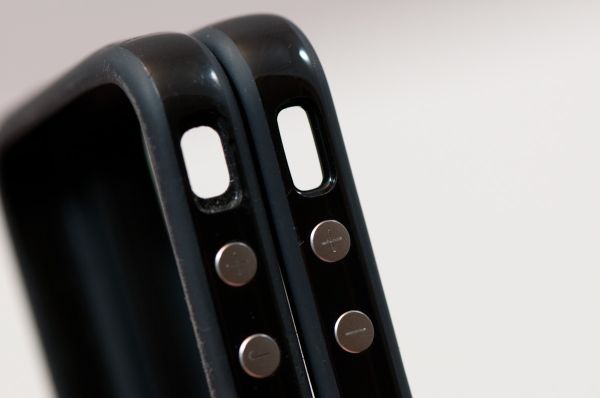
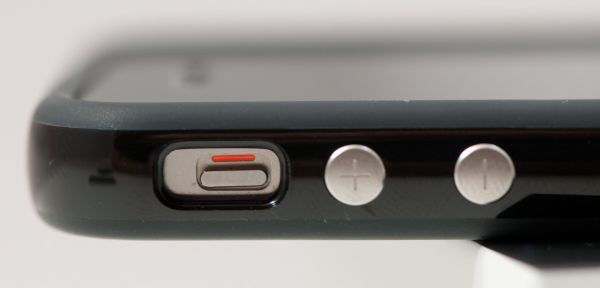








35 Comments
View All Comments
hsew - Sunday, February 13, 2011 - link
lolnoobs and LOLphone?I lol'd at the speed tests. Makes me wish I bought an iPad when the data was still unlimited.
guest123 - Sunday, February 13, 2011 - link
First off, thanks for the typically thorough review, Brian.I wonder, though, about your conclusion that the Verizon iPhone is "significantly less prone to unintended signal attenuation." True, in the "cupping tightly" scenario the Verizon iPhone is now in line with other leading smartphones, and in the "holding naturally" scenario it improves on the performance of the At&T model. But the Verizon iPhone is still significantly more prone to attenuation in the "holding naturally" scenario than any of the phones you've listed. To me, this was always the real point of the attennagate controversy: as your chart shows, the At&T iPhone is more prone to attenuation when held naturally than other phones are when held in a death grip. Based on your results, the Verizon version has improved, but only to the extent that it attenuates about as badly when held naturally as other phones do when death-gripped. That still seems like a non-trivial problem.
jmcb - Monday, February 14, 2011 - link
I'm glad I'm not the only one who noticed that.....jmcb - Monday, February 14, 2011 - link
Noticed that when held naturally its still worse than any other phone on the list....7Enigma - Tuesday, February 15, 2011 - link
I agree with you as well. I did not like the wording in this section as 99% of people using a PHONE are going to hold it like a PHONE. So while the other numbers are nice to have for specific usage scenarios, the one that is the most important, while improved, is still significantly worse than anything else (other than the AT&T iPhone).mike55 - Sunday, February 13, 2011 - link
I've noticed that the AT&T iPhone 4's have varying degrees of warmer screens than the relatively cooler screen on the AT&T unit you mentioned in this review. I would be interested in seeing how the different screens compare in terms of black level, maximum brightness, color accuracy, etc.Maybe you guys could get a bunch of units and compare them. It would be interesting to see how other smartphones fare in terms of display panel variance from unit to unit. I'm sure all of the display nerds like myself would appreciate such an article. :D
cgalyon - Sunday, February 13, 2011 - link
How does this review not say, "it's the iPhone 4, on Verizon. The radio is different, the rest is the same."?7Enigma - Tuesday, February 15, 2011 - link
If that's what you think why click on the review? And why comment?Voldenuit - Sunday, February 13, 2011 - link
Well, obviously the EU regulatory iconography (CE, CE compliance identifier, CE Alert icon) didn't need to exist anymore since a CDMA phone is pretty useless in Europe.I'm surprised that the FCC label also vanished, though.
LTG - Monday, February 14, 2011 - link
1) Great facts - You somehow took a topic I thought would be a snoozer and extracted quite a bit of interesting detail i hadn't read before.2) Great prose - The general approach, style, and constant attention to what readers are thinking. Feels like we're discovering it all with you.
3) Technical writing mistakes - i didnt notice any! I know it sounds like a really lame point. But it actually is a nice benefit to not be jarred out concentration by typos or grammar mistakes. Its like a luxury on the Internet and makes the experience so smooth.
With all the comments critical of writing here I think its fair to call out the opposite side as well.
Peace -